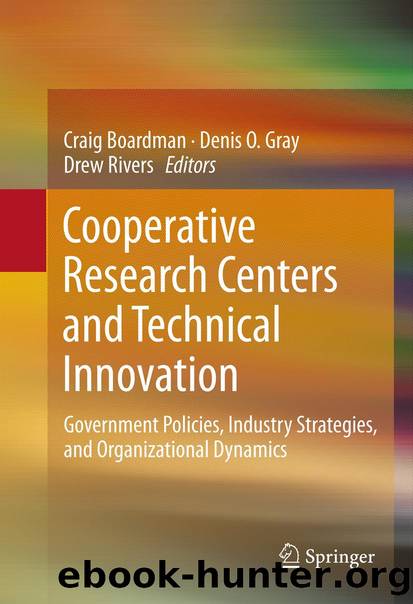Cooperative Research Centers and Technical Innovation by Craig Boardman Denis O. Gray & Drew Rivers

Author:Craig Boardman, Denis O. Gray & Drew Rivers
Language: eng
Format: epub
Publisher: Springer New York, New York, NY
7.6 Conclusion: Limitations and Future Research
Our conceptualization of LMX quality and use of the LMX-7 to measure it was consistent with most research concerning this construct (Erdogan and Liden 2002; Gerstner and Day 1997; Graen and Uhl-Bien 1995), but it may ignore other important aspects of LMX (Schriesheim et al. 1999). In addition to attributes assessed with the LMX-7 scale, exchange aspects of the leadership relationship may also include affect, loyalty, contribution, and professional respect (Liden and Maslyn 1998). Future research should consider using broader measures of LMX that may capture its full range. Moreover, other aspects of the leadership relationship beyond LMX quality and trust may be important. When combined with trust, collaborative leadership that provides a vision that encourages “frame-breaking solutions” and creates organizational structures that seek these solutions across-disciplinary boundaries may be most effective (B. Gray 2008). “High quality connections” that focus on creation of identity, growth and development, and learning in an effort to “enliven” people may be important as well (Dutton and Heaphy 2003). Beyond the focus on leader relationship, future research should also examine transformational leadership style, team leadership, and leadership focused on boundary spanning as these also influence innovation (Elkins and Keller 2003).
We tested the influence of leadership at two levels of analysis. We examined the dyadic level involving center directors and the university administrator to whom they report who were located within a single university. The dyadic level has been most commonly used to examine leadership relationships (Graen and Uhl-Bien 1995), and our results confirm the importance of this level of analysis. Recent theorizing about leadership has expanded its focus beyond individuals and dyads to include teams and organizations (Yammarino et al. 2001). Moreover, leadership relationships have been viewed more broadly as a means of fostering social capital throughout the organization by fostering high LMX relationships with everyone (Uhl-Bien et al. 2000). By developing strong relationships with everyone, managers build social capital that they may use to achieve important organizational outcomes such as innovation. Strong relationships therefore emerge upward and expand throughout the organization after they have been developed in dyads. For example, trust throughout the organization increases as more dyadic relationships become trusting. This view is consistent with research showing that positive affect spreads throughout social networks and clusters in groups of people that extend up to three degrees of separation “to one’s friends’ friends’ friends’” (Fowler and Christakis 2008). Using this logic, we expected that directors of university research sites would share a similar profile of leadership relationships with their university administrator as that reported by the center director. Cooperative research centers that involve researchers from multiple universities must be managed as a single center, thus yielding an organizational entity with shared identity, attitudes, beliefs, and values. We examined the center level of analysis, which aggregated perceptions from multiple university research sites that were members of the same center in order to assess existence of a center level effect. We failed to find a center level effect; leadership relationships varied independently on a university-by-university basis.
Download
This site does not store any files on its server. We only index and link to content provided by other sites. Please contact the content providers to delete copyright contents if any and email us, we'll remove relevant links or contents immediately.
International Integration of the Brazilian Economy by Elias C. Grivoyannis(57323)
The Radium Girls by Kate Moore(10907)
Turbulence by E. J. Noyes(7039)
Nudge - Improving Decisions about Health, Wealth, and Happiness by Thaler Sunstein(6633)
The Black Swan by Nassim Nicholas Taleb(6190)
Pioneering Portfolio Management by David F. Swensen(5606)
Rich Dad Poor Dad by Robert T. Kiyosaki(5149)
Zero to One by Peter Thiel(4824)
Man-made Catastrophes and Risk Information Concealment by Dmitry Chernov & Didier Sornette(4736)
Secrecy World by Jake Bernstein(3782)
Millionaire: The Philanderer, Gambler, and Duelist Who Invented Modern Finance by Janet Gleeson(3569)
Skin in the Game by Nassim Nicholas Taleb(3460)
The Age of Surveillance Capitalism by Shoshana Zuboff(3422)
The Money Culture by Michael Lewis(3284)
Skin in the Game: Hidden Asymmetries in Daily Life by Nassim Nicholas Taleb(3264)
Bullshit Jobs by David Graeber(3179)
The Dhandho Investor by Mohnish Pabrai(3168)
The Wisdom of Finance by Mihir Desai(3078)
Blockchain Basics by Daniel Drescher(2890)
